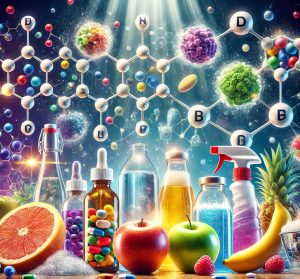Replication is a crucial molecular process in the basis of inheritance, responsible for the duplication of genetic material in all living organisms. This process ensures that each new cell inherits an identical copy of the genetic instructions stored in DNA. DNA replication is fundamental to biological inheritance, growth, and cell division, as it allows genetic information to be passed from one generation to the next. The replication mechanism is precise and complex, involving multiple enzymes, coordination, and regulation to maintain genetic fidelity. Here’s an in-depth explanation of DNA replication, its mechanisms, and its importance in molecular inheritance.
1. Overview of DNA Structure and Its Role in Replication
DNA, or deoxyribonucleic acid, is composed of two long chains of nucleotides twisted into a double helix. Each nucleotide consists of a sugar molecule (deoxyribose), a phosphate group, and one of four nitrogenous bases—adenine (A), thymine (T), cytosine (C), and guanine (G). The bases pair in a specific manner, with adenine pairing with thymine and cytosine with guanine. This complementary base-pairing is essential for DNA’s ability to store and replicate information, as each strand in the double helix serves as a template for the synthesis of a new strand.
The DNA structure allows it to carry genetic information and provides a blueprint for replication. When cells divide, the DNA double helix unwinds, and each strand acts as a template for creating two identical DNA molecules. This process, known as semi-conservative replication, results in each new DNA molecule containing one old (parental) strand and one newly synthesized strand. This method of replication ensures the fidelity of genetic information.
2. Key Steps of DNA Replication
DNA replication is a highly coordinated process that occurs in several steps, each involving specific enzymes and proteins:
Step 1: Initiation
The replication process begins at specific locations called origins of replication, where replication forks form as the DNA unwinds. In prokaryotes, there is typically a single origin of replication, while eukaryotic chromosomes have multiple origins to facilitate efficient replication. The origin of replication is rich in adenine and thymine bases, making it easier for the DNA strands to separate.
Step 2: Unwinding the DNA Helix
To start replication, the double helix must be unwound to expose the template strands. This is accomplished by the enzyme helicase, which breaks the hydrogen bonds between the base pairs, separating the two DNA strands. The resulting Y-shaped structure is known as the replication fork. As helicase unwinds the DNA, it generates tension ahead of the replication fork, which is alleviated by topoisomerase. Topoisomerase prevents supercoiling and allows the DNA to unwind smoothly.
Single-strand binding proteins attach to the separated strands to prevent them from re-annealing or forming secondary structures, keeping them stable and accessible for the next steps.
Step 3: Primer Synthesis
DNA polymerase, the main enzyme responsible for synthesizing new DNA strands, cannot initiate replication on its own. It requires a short RNA primer to which it can add nucleotides. This primer is synthesized by the enzyme primase, which synthesizes a short RNA sequence complementary to the template strand. The RNA primer provides a free 3′ hydroxyl (OH) group for DNA polymerase to begin DNA synthesis.
Step 4: DNA Synthesis by DNA Polymerase
Once the primer is in place, DNA polymerase adds nucleotides complementary to the template strand in the 5′ to 3′ direction. DNA polymerase catalyzes the formation of phosphodiester bonds between nucleotides, creating a new DNA strand. However, DNA synthesis occurs differently on each template strand because DNA polymerase can only add nucleotides in the 5′ to 3′ direction.
- Leading Strand Synthesis: On the leading strand, DNA polymerase continuously synthesizes DNA in the same direction as the replication fork, producing a complementary strand without interruption.
- Lagging Strand Synthesis: On the lagging strand, DNA polymerase synthesizes DNA in the opposite direction of the replication fork. This results in the formation of short, discontinuous fragments known as Okazaki fragments. Each Okazaki fragment requires its own RNA primer. Once an Okazaki fragment is synthesized, DNA polymerase moves back to the replication fork to start another fragment.
Step 5: Primer Removal and DNA Ligase
After DNA synthesis is complete, the RNA primers are removed by an enzyme called DNA polymerase I in prokaryotes or RNase H in eukaryotes, which replaces the RNA nucleotides with DNA. Gaps left by the removal of RNA primers are filled by DNA polymerase. Finally, the enzyme DNA ligase joins the Okazaki fragments on the lagging strand, sealing the phosphodiester bonds and creating a continuous DNA strand.
3. Proofreading and Error Correction Mechanisms
DNA replication is remarkably accurate, with an error rate of less than one mistake per billion nucleotides. This accuracy is due to the proofreading ability of DNA polymerase, which detects and corrects errors as it synthesizes the new strand. If an incorrect nucleotide is incorporated, DNA polymerase pauses, removes the incorrect base using its exonuclease activity, and inserts the correct one before resuming synthesis.
In addition to proofreading, cells have several DNA repair mechanisms to address errors or damage to the DNA. For example, mismatch repair enzymes detect and fix mismatched bases that escape proofreading, ensuring high fidelity in replication.
4. Regulation of DNA Replication
DNA replication is tightly regulated to ensure it occurs only once per cell cycle. In eukaryotes, replication occurs during the S phase (synthesis phase) of the cell cycle. Regulatory proteins ensure that each origin of replication is activated only once per cycle, preventing over-replication or under-replication of genetic material.
5. Differences Between Prokaryotic and Eukaryotic DNA Replication
DNA replication occurs similarly in prokaryotes and eukaryotes, but there are some differences:
- Origins of Replication: Prokaryotes typically have a single origin of replication, while eukaryotes have multiple origins to accommodate the larger genome.
- Replication Enzymes: While both systems use similar enzymes (helicase, primase, DNA polymerase, ligase), eukaryotic cells have a more complex array of DNA polymerases specialized for different roles in replication and repair.
- Chromatin Structure: Eukaryotic DNA is wrapped around histone proteins to form chromatin, requiring additional steps to unwind and reassemble chromatin as replication proceeds.
6. Importance of DNA Replication in Inheritance
DNA replication is essential for inheritance, as it ensures that each daughter cell receives an identical copy of the genome. This accurate transmission of genetic information allows organisms to pass on traits to their offspring. Mutations that arise during replication can be inherited if they occur in germ cells (sperm or egg), contributing to genetic variation. However, excessive or uncorrected mutations can lead to diseases or disorders.
7. DNA Replication Errors and Mutations
Although replication is highly accurate, errors can still occur. When mistakes are not corrected, they can lead to mutations, which may affect an organism’s traits. Some mutations may be neutral, while others can be harmful or beneficial. Mutations that occur in somatic cells can contribute to cancer and other diseases, while mutations in germ cells can be passed on to the next generation, influencing evolution.
8. DNA Replication and Cancer
Cancer can arise from unregulated cell division due to mutations in genes that control the cell cycle. If DNA repair mechanisms are faulty, mutations can accumulate, leading to abnormal cell proliferation and tumor development. Some anticancer treatments target DNA replication enzymes to disrupt the rapid division of cancer cells, although this can also affect healthy cells.
9. Applications of DNA Replication in Biotechnology
DNA replication principles are fundamental to many biotechnological applications, including:
- Polymerase Chain Reaction (PCR): PCR is a technique used to amplify specific DNA sequences for research, diagnostics, and forensic science. It uses synthetic primers, heat-resistant DNA polymerase, and repeated heating-cooling cycles to replicate DNA in vitro.
- DNA Sequencing: DNA sequencing technologies rely on replication-like processes to read the order of bases in DNA. Sequencing helps identify genes, detect mutations, and understand genetic diseases.
- Gene Editing and CRISPR: Gene editing tools like CRISPR involve DNA replication to integrate new genetic material into specific genome sites, enabling precise genetic modifications.
10. Conclusion: The Significance of DNA Replication in Molecular Inheritance
DNA replication is essential for the continuity of life, ensuring the accurate transmission of genetic information to new cells and offspring. The precision and regulation of this process are crucial to maintaining genetic stability and enabling evolution. While highly accurate, DNA replication is also a source of genetic diversity, as occasional mutations contribute to variation within populations. Understanding DNA replication not only provides insights into the molecular basis of inheritance but also enables advancements in medicine, genetics, and biotechnology.
10 Questions DNA Replication and the Molecular basis of inheritance:
1. What is the primary purpose of DNA replication?
- Answer: The primary purpose of DNA replication is to ensure that each new cell formed after cell division has an exact copy of the organism’s genetic material. This process is vital for growth, development, and reproduction in living organisms. DNA replication allows for the inheritance of genetic information from parent cells to daughter cells, maintaining continuity and consistency of genetic traits across generations.
2. What does ‘semi-conservative replication’ mean?
- Answer: Semi-conservative replication means that each new DNA molecule consists of one original (parental) strand and one newly synthesized strand. During replication, the DNA double helix unwinds, and each strand serves as a template for the formation of a new complementary strand. This process conserves one of the original strands in each new DNA molecule, ensuring accurate transmission of genetic information.
3. Why is helicase important in DNA replication?
- Answer: Helicase is an enzyme that unwinds the DNA double helix by breaking the hydrogen bonds between the base pairs, separating the two strands. This separation creates a structure known as the replication fork, which allows other enzymes to access the single strands and initiate DNA synthesis. Without helicase, the DNA would remain in its tightly wound form, and replication could not proceed efficiently.
4. What is the function of primase in DNA replication?
- Answer: Primase is an enzyme that synthesizes a short RNA primer complementary to the DNA template strand. DNA polymerase, the main enzyme responsible for adding nucleotides to form the new DNA strand, cannot initiate synthesis on its own and requires a starting point. The RNA primer created by primase provides a free 3′ hydroxyl group for DNA polymerase to begin adding nucleotides, allowing replication to proceed.
5. How does DNA polymerase synthesize new DNA strands?
- Answer: DNA polymerase synthesizes new DNA by adding nucleotides complementary to the template strand in the 5′ to 3′ direction. It reads the template strand and adds matching nucleotides to the growing strand by forming phosphodiester bonds. DNA polymerase has high accuracy, as it can proofread and correct mistakes in real-time, ensuring fidelity in the replicated DNA. This enzyme is essential for the accurate and efficient synthesis of new DNA strands during replication.
6. What are Okazaki fragments, and why do they form?
- Answer: Okazaki fragments are short DNA segments synthesized discontinuously on the lagging strand during DNA replication. DNA polymerase can only add nucleotides in the 5′ to 3′ direction, so on the lagging strand, which runs in the opposite direction of the replication fork, it must synthesize DNA in small segments as the fork opens up. Once each fragment is synthesized, they are eventually joined together by DNA ligase to form a continuous strand.
7. Why is DNA ligase essential in the replication process?
- Answer: DNA ligase is an enzyme that connects the Okazaki fragments on the lagging strand by forming phosphodiester bonds between them. This enzyme is crucial because it seals any gaps left after the RNA primers are replaced with DNA, creating a continuous DNA strand. DNA ligase ensures that the newly replicated DNA molecule is structurally complete and stable, ready to be passed on to new cells during cell division.
8. What role does proofreading play in DNA replication?
- Answer: Proofreading is a quality-control function carried out by DNA polymerase during replication. As DNA polymerase adds nucleotides, it checks each one for correct base pairing. If an incorrect nucleotide is incorporated, DNA polymerase can remove and replace it with the correct base. This proofreading mechanism significantly reduces the error rate in DNA replication, ensuring the high fidelity necessary for accurate genetic inheritance and preventing mutations.
9. How do prokaryotic and eukaryotic DNA replication differ?
- Answer: While the fundamental steps of DNA replication are similar in both prokaryotes and eukaryotes, there are key differences. Prokaryotes have a single circular chromosome with one origin of replication, making replication faster and simpler. In contrast, eukaryotic chromosomes are linear and larger, with multiple origins of replication along each chromosome. This arrangement allows simultaneous replication at multiple points, accommodating the larger genome size in eukaryotes and ensuring timely completion of replication during cell division.
10. Why is DNA replication essential for inheritance and evolution?
- Answer: DNA replication is essential for inheritance because it enables each new cell or offspring to receive an identical copy of genetic information from its parent. This fidelity in replication ensures that traits and genetic characteristics are consistently passed on through generations. Additionally, occasional mutations during replication contribute to genetic variation, which is the basis for evolution. Natural selection acts on this variation, driving the adaptation and evolution of species over time.






